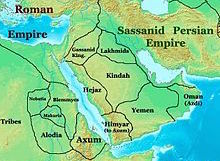The conquering Ethiopian Emperor-King of Axum
A common mental-image of a
Christian saint depicts a kind-hearted and charitable person who does good deeds
all day long until he retires back to his cloister for the night. While people
like this often make up the long list of saints, there are quite a few
anomalous people that break the saintly mold. This is one startling saint that stands
out among the saintly and may not be commonly known—Saint Elesbaan of
Ethiopia.
(St Elesbaan painting, [Public Domain] circa
1750 oil on canvas, 110 by 75 cm (original in Museu de Arte Sacra, Arouca,
Portugal))
The King of Axum
This saint lived in the 6th
century CE, which makes the names of historically relevant places and people
complicated. Different cultures and historians recorded the life of this saint
in various ways. Saint Elesbaan is also known as Ella Asheha, or simply as Caleb or Kaleb. Elesbaan’s kingdom in
Ethiopia can be referred to as either Axum or Aksum. Elesbaan invaded a Yemeni
Kingdom of the Himyarites or Homerites. Finally, the King of the Himyar Kingdom
was known as either Dunaan or Dhu Nowas. Phew, all that is over. For the
purpose of this article, we will continue the story using the names Elesbaan
and Dunaan, in their respective kingdoms of Axum and Himyar. That concludes the
bland scholarly portion of this article. On to the life and events of Saint
Elesbaan.
Elesbaan became king of Axum
in the early 6th century, likely somewhere between 514 and 518 CE. Axum
was a powerful Christian kingdom that extended from modern Ethiopia down into
Somalia. The Kingdom of Axum was a major economic power in Africa and the
Middle East, and it also had friendly relations with the Eastern Roman-Byzantine
Empire. Suffice it to say; Elesbaan had significant power and influence.
(Approximate Axum and Himyar map c 560s by
Talessman, [Public Domain] via Creative
Commons)
The Beginnings of a Feud
Across the Red Sea, a new
king was on the rise in Yemen. King Dunaan likely gained the Himyar throne in
the last decade of the 5th century. Dunaan was a Jewish King and led
a Jewish Kingdom, however, Yemen was also the home of a large Christian
population. As happens too often in history when cultures and religions
collide, the Himyar Kingdom persecuted its religious minorities—which, in this
case, included Christians.
Elesbaan soon heard of the
Himyar persecution of Christians and mobilized the powerful Kingdom of Axum for
war. At some time before 520 CE, the Axumite forces crossed the Red Sea,
invaded Yemen and forced the Himyar King Dunaan into hiding. King Elesbaan
instituted an Axumite viceroy to rule Yemen and, shortly thereafter, sailed
back to Ethiopia.
Elesbaan may have defeated
the Himyar Kingdom, but he had not captured King Dunaan. The Himyar king bid
his time, slowly regaining Yemini support and rebuilding his army. By the early
520s CE, King Dunaan was ready to make his move.
King Dunaan struck quickly
against the Axumite Viceroyalty and massacred the Christian population in the
city of Negran. Christian leaders, like Bishop Simeon of Beth Arsham, quickly and
efficiently spread news of the massacre, eventually reaching most of the major
Christian powers—including the Byzantine Empire and the Kingdom of Axum.
The Final Showdown
King Elesbaan received
multiple letters from clergymen urging another war against King Dunaan. He even
received a message from the Byzantine Emperor, Justin I, promising the
assistance of around 60 Byzantine ships to help ferry Axumite troops across the
Red Sea to Yemen.
(Imperial coins of Justin I, [Public Domain] via
Classical Numismatic Group and Creative Commons)
Elesbaan quickly seized the
opportunity to finally rid himself of his old foe. In 523, Axum again
invaded Yemen and crushed the forces of King Dunaan. Dunaan’s fate differs
depending on the source. Some accounts claim King Dunaan committed suicide.
Others report that he was killed in battle, or executed by King Elesbaan.
Nonetheless, Dunaan did not survive the second Axumite invasion.
With Yemen once more under
his control, King Elesbaan imposed another viceroyalty in the region. Elesbaan
returned again to his homeland of Ethiopia, likely believing that the rest of
his reign would be peaceful. One of his own military officers, however, proved
him wrong.
War and Peace
Abraha, one of Elesbaan’s
officers who participated in the war that overthrew King Dunaan, was
unimpressed with Elesbaan’s choice for the viceroyalty. With the backing of his
own military supporters, Abraha usurped the position of viceroy for himself.
(Duel between the Ethiopian generals Abraha and
Aryat, from a Tarikhnama (Book of history) by Balami c 14th century, [Public
Domain] via Creative Commons)
Elesbaan could not let this
insubordination go unanswered. He, again, called on his military to invade
Yemen. Abraha was able to fend off two invasions from Elesbaan’s forces, the
conflict continuing into the 540s CE. Eventually, Elesbaan recognized Abraha as
the viceroy of Yemen and the two coexisted peacefully.
Shortly after he accepted
Abraha, Elesbaan decided he wanted nothing more to do with power and warfare.
He resigned from his position as the King of Axum, became an ascetic monk and
disappeared from the records of history. It is likely that Elesbaan died in the
mid-550s CE.
Written by C. Keith Hansley
thehistorianshut.com
- http://catholicsaints.info/saint-elesbaan-of-ethiopia/
- http://oca.org/saints/lives/2016/10/24/103048-blessed-elesbaan-the-king-of-ethiopia
- http://www.bartleby.com/210/10/272.html
- http://www.ccel.org/ccel/wace/biodict.html?term=Elesbaan,%20king,%20hermit,%20and%20saint%20of%20Ethiopia
- http://www.voskrese.info/spl/Xellasbaan.html
- http://www.friesian.com/ethiopia.htm
- https://www.britannica.com/place/Aksum-ancient-kingdom-Africa
- https://www.britannica.com/topic/Himyar
- http://www.christianity.com/church/church-history/timeline/301-600/arabian-christians-massacred-11629705.html
- https://www.britannica.com/biography/Abraha
- http://www.dacb.org/stories/ethiopia/_abraha.html




No comments:
Post a Comment